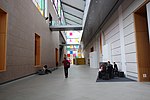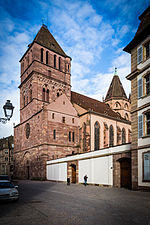Strasbourg Mosque

The Strasbourg Mosque or Great Mosque of Strasbourg (French: Grande Mosquée de Strasbourg) is a large purpose-built Islamic mosque in the French city of Strasbourg. It is located on the banks of the Ill river in the Heyritz area, south of the Grande Île. It was inaugurated in September 2012 and has a capacity of 1,200 people.The mosque is frequented by Muslims of North Africa, mainly Moroccan origin. It hosts many conferences and seminars and has an extensive teaching programme for school-aged children. The former mosque, in use from 1982 to 2012, consisted of a converted foie gras factory in the Impasse de mai in the centre of Strasbourg, near the law-courts. It was not the first mosque to be established in Strasbourg. There have been mosques in the city since 1967 and there are now over twenty.
Excerpt from the Wikipedia article Strasbourg Mosque (License: CC BY-SA 3.0, Authors, Images).Strasbourg Mosque
Rue Averroès, Strasbourg Neudorf-Musau
Geographical coordinates (GPS) Address External links Nearby Places Show on map
Geographical coordinates (GPS)
| Latitude | Longitude |
|---|---|
| N 48.573055555556 ° | E 7.7371666666667 ° |
Address
Grande Mosquée de Strasbourg
Rue Averroès
67003 Strasbourg, Neudorf-Musau
Grand Est, France
Open on Google Maps








